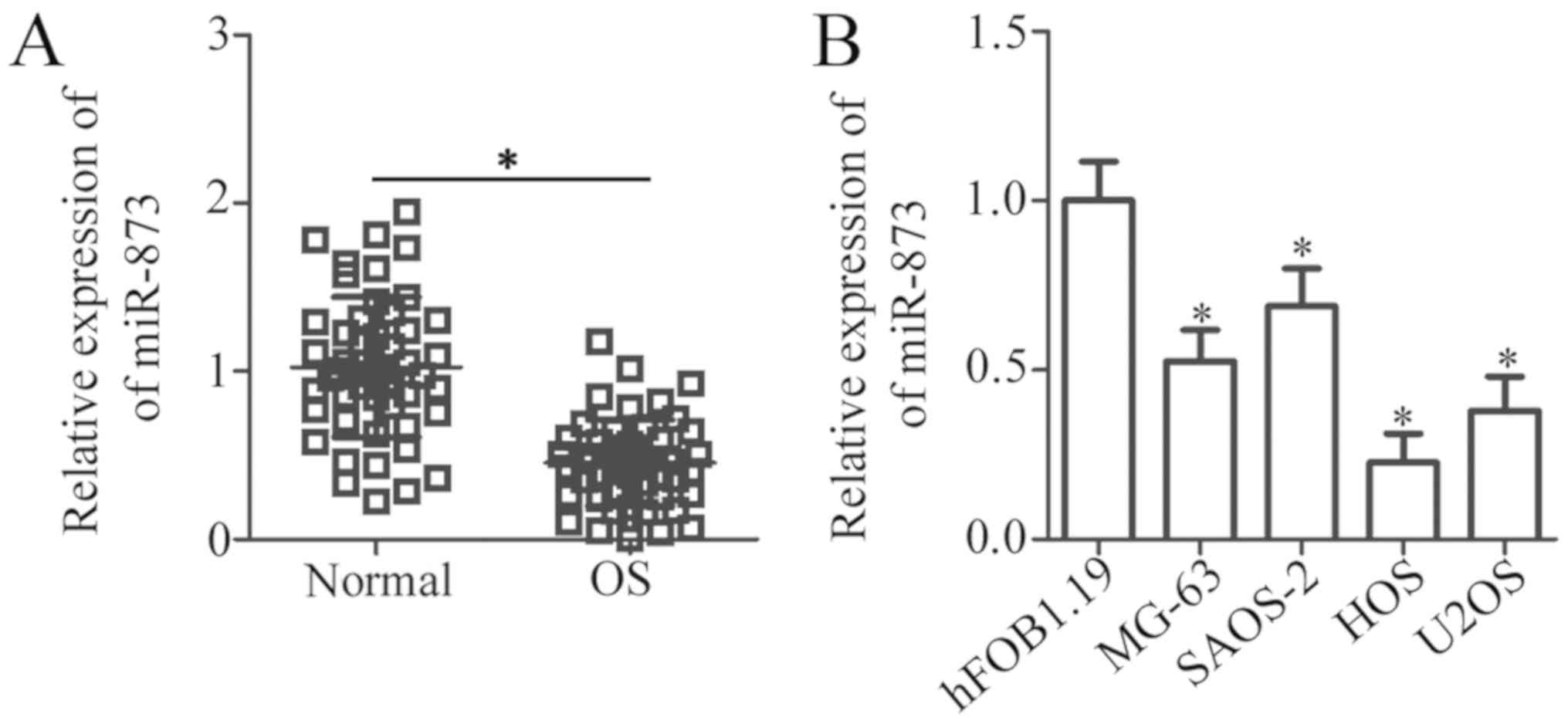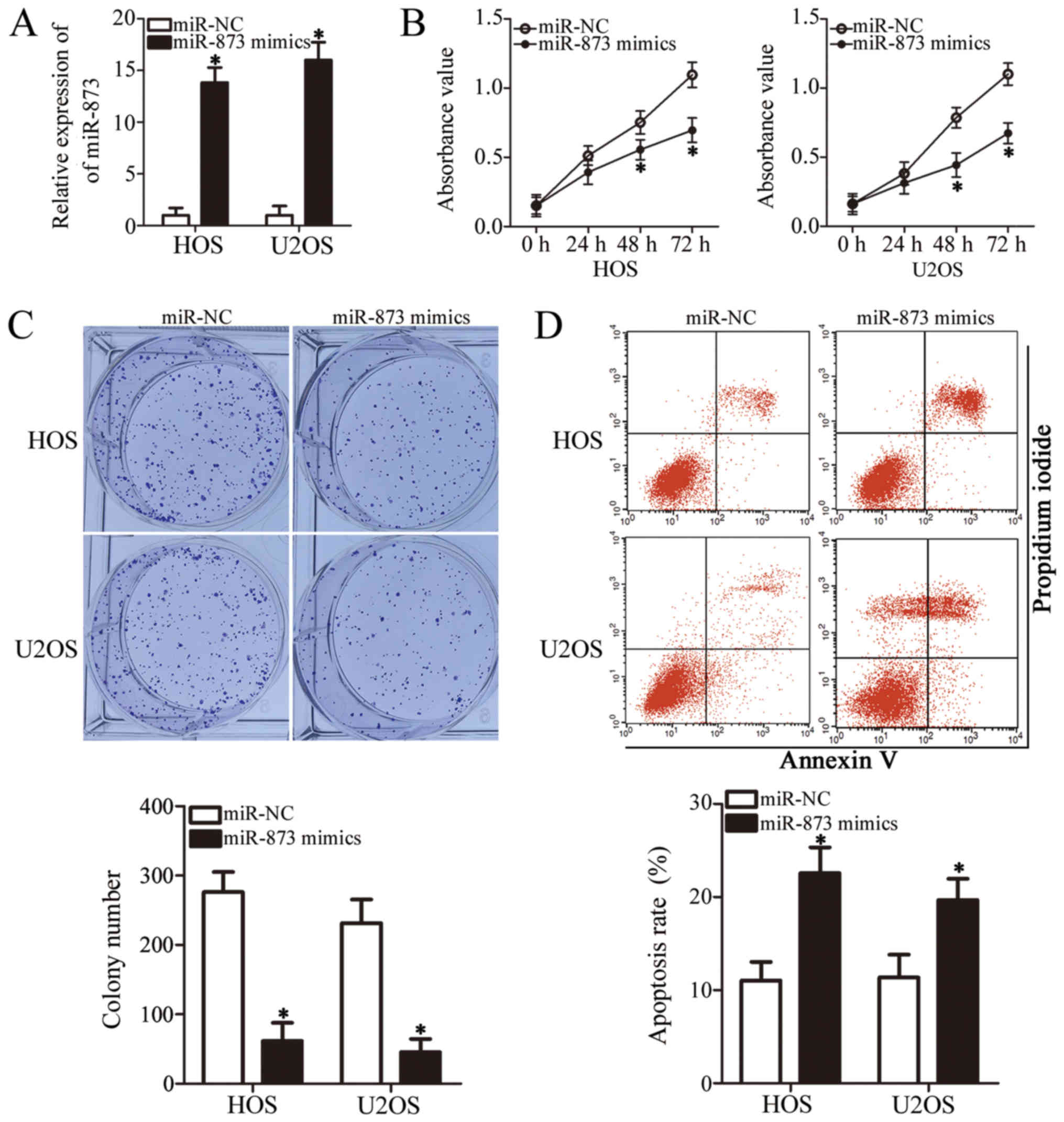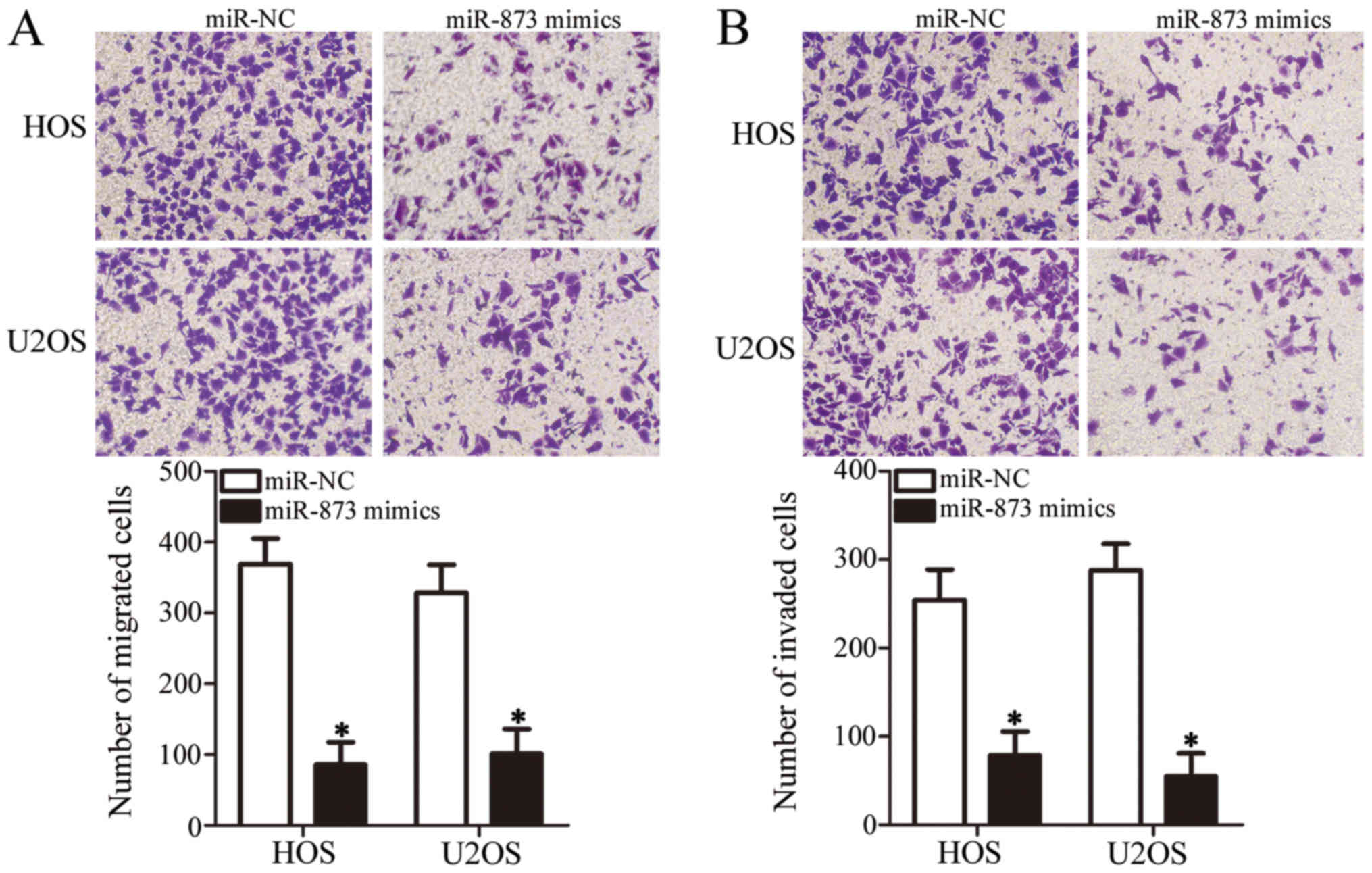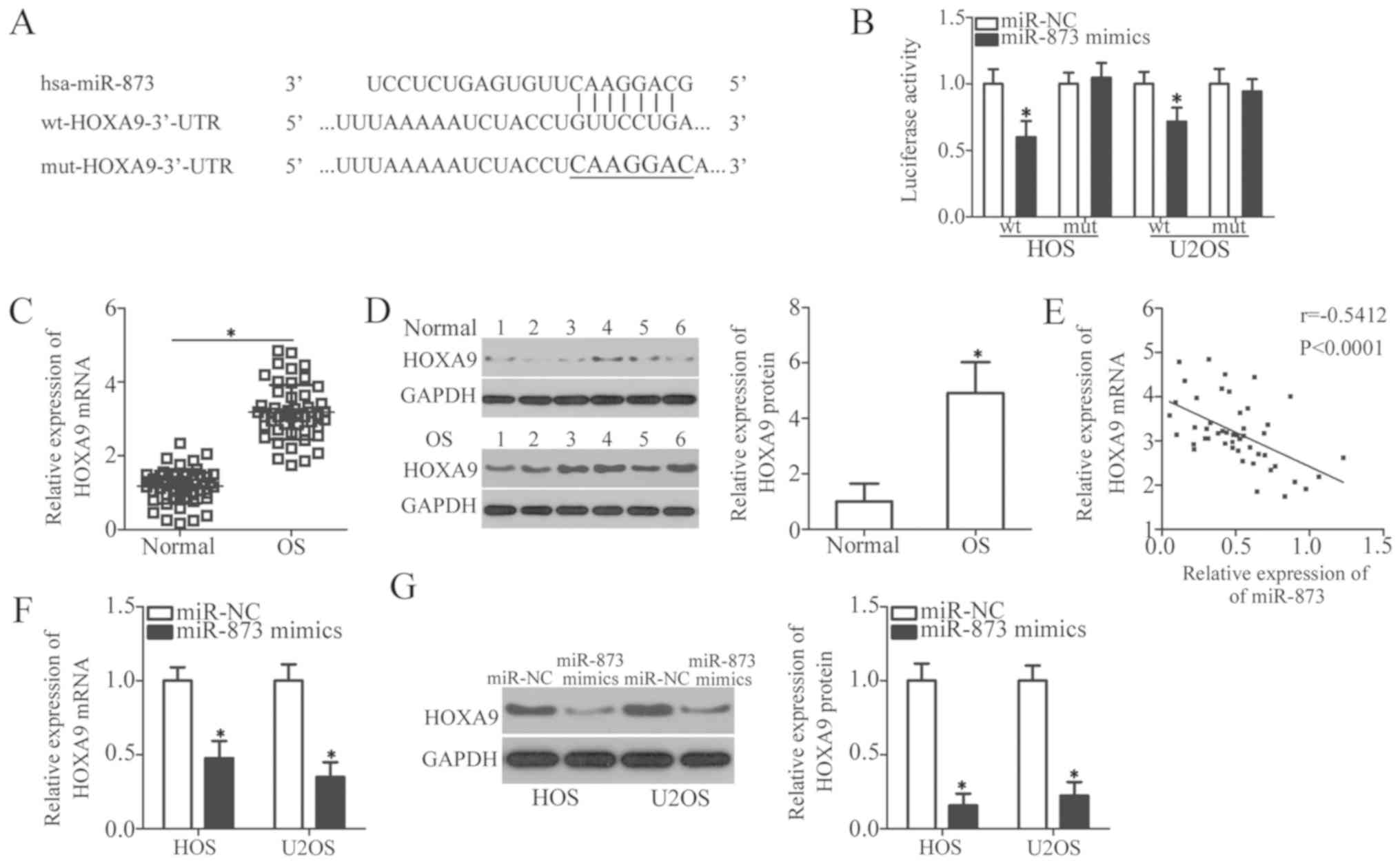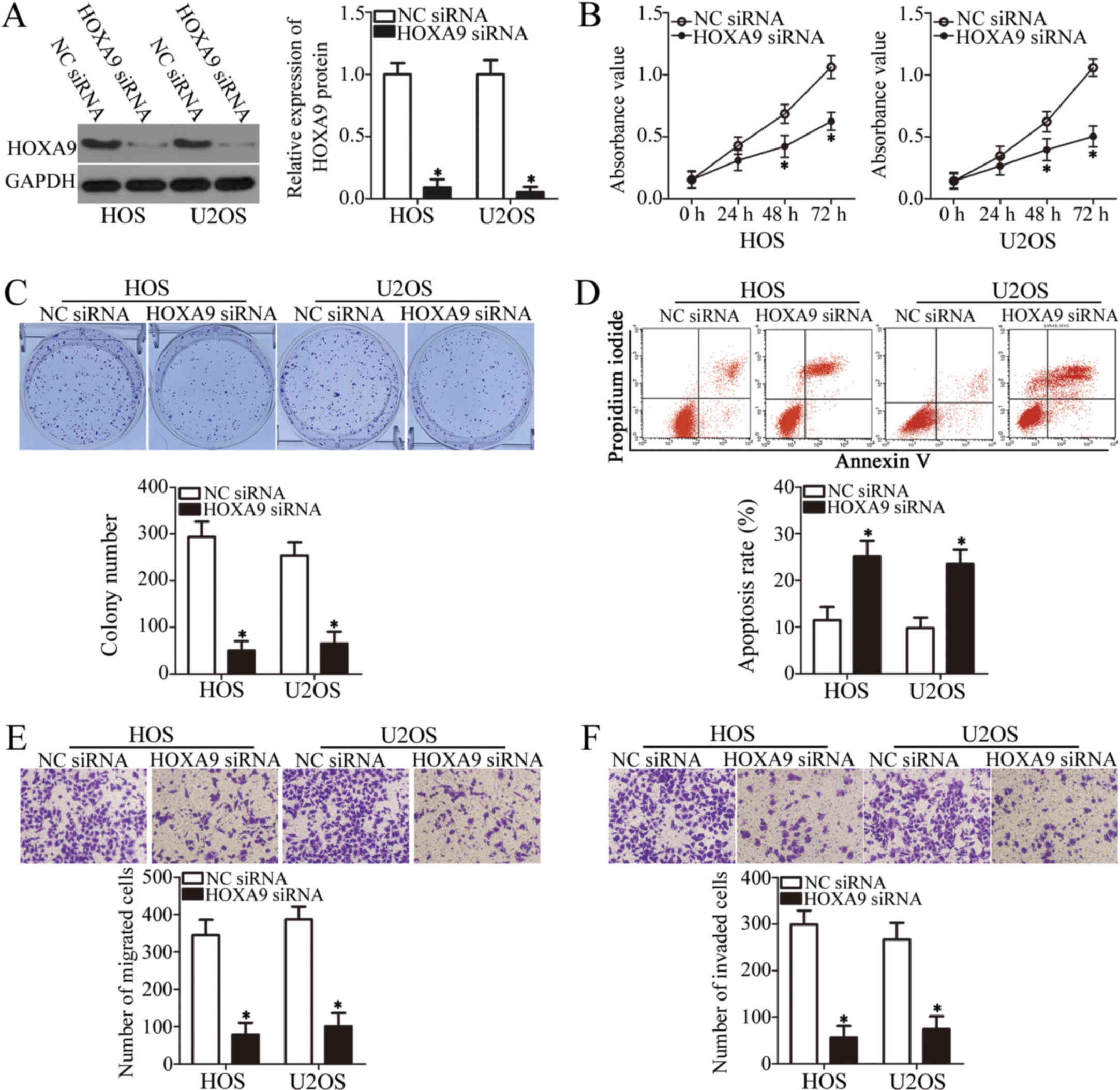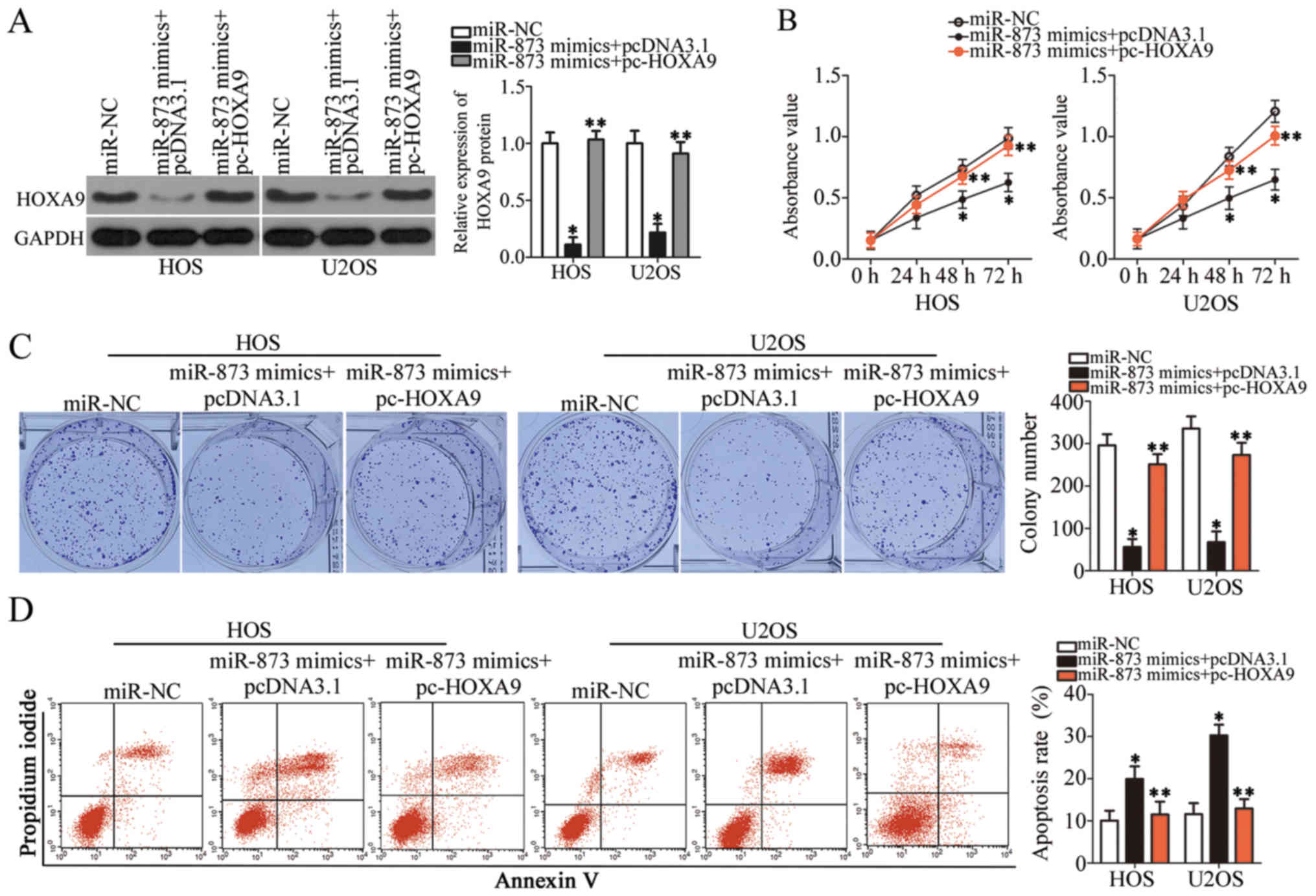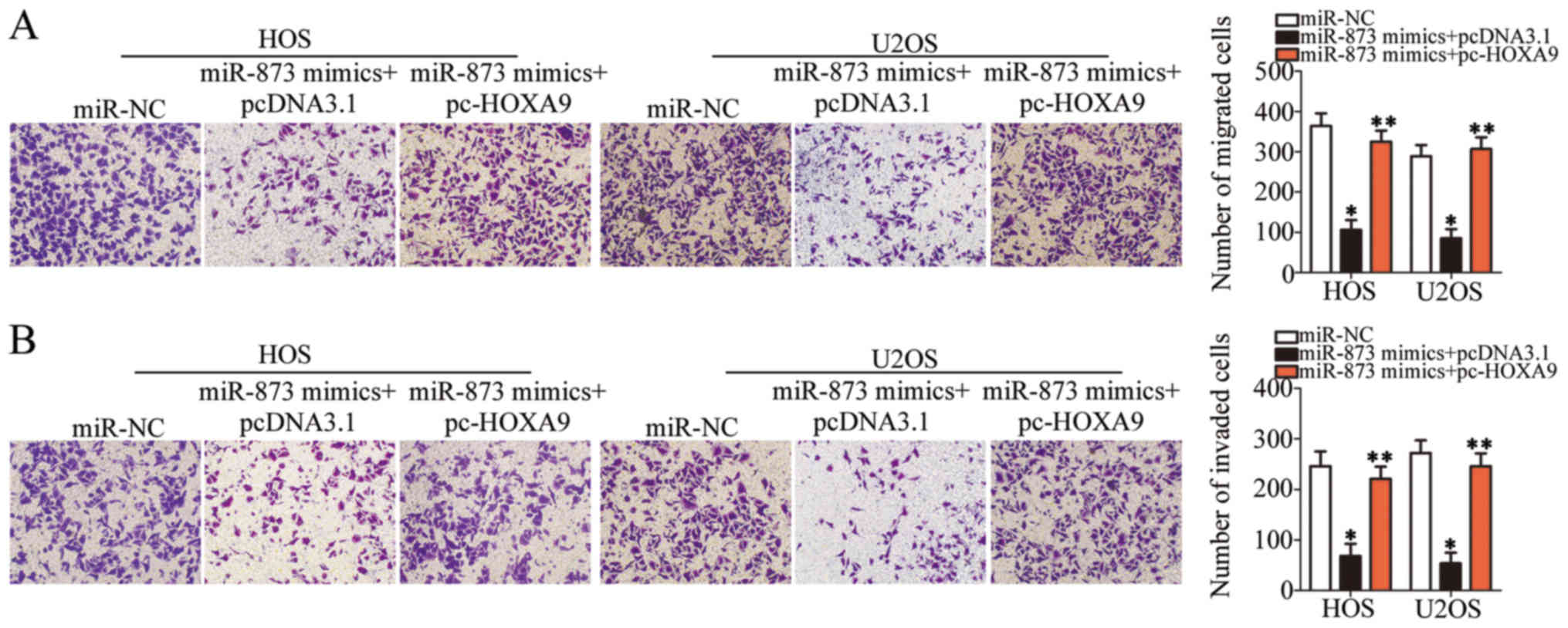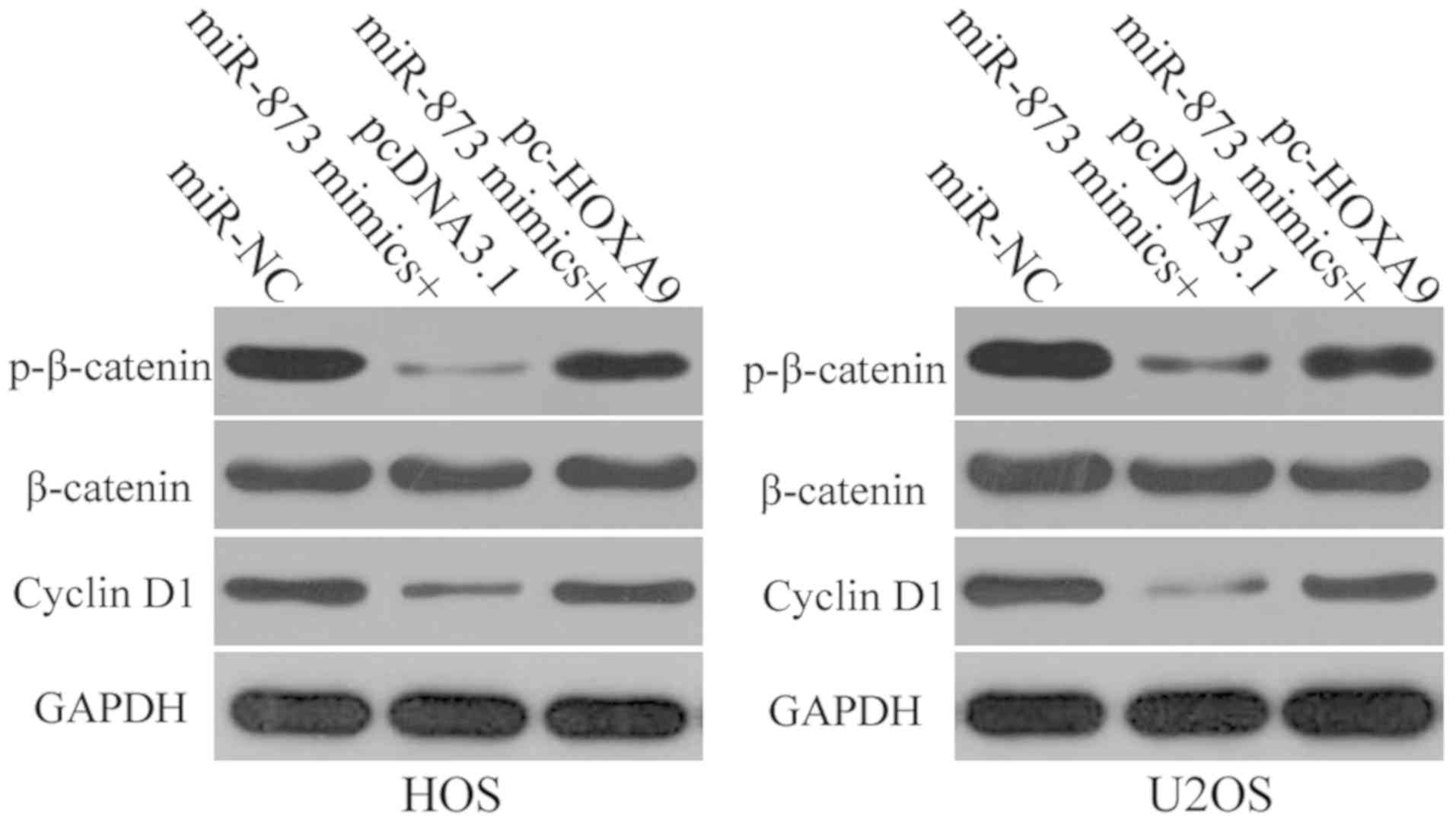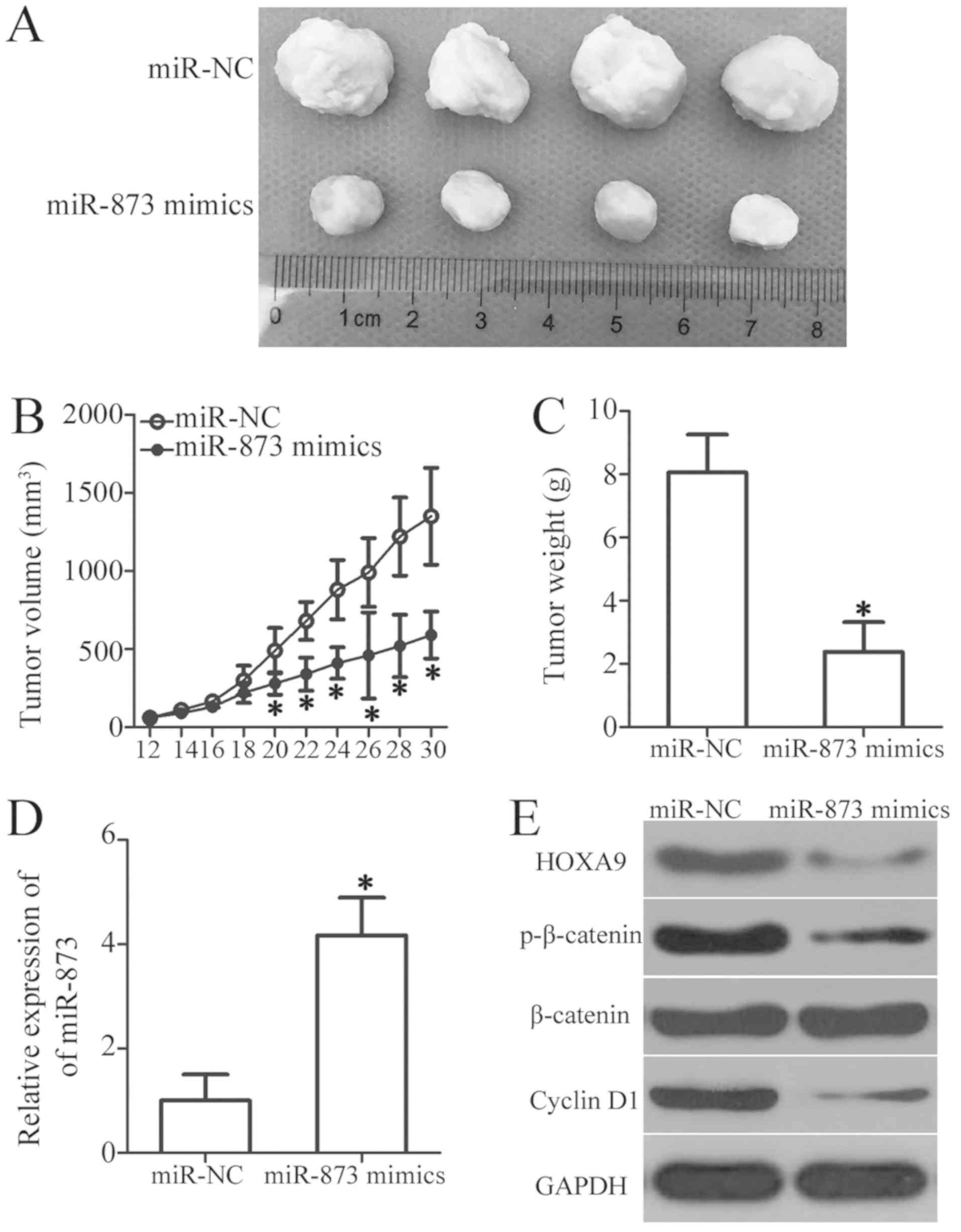|
1
|
Ta HT, Dass CR, Choong PF and Dunstan DE:
Osteosarcoma treatment: State of the art. Cancer Metastasis Rev.
28:247–263. 2009.
|
|
2
|
Tang J, Shen L, Yang Q and Zhang C:
Overexpression of metadherin mediates metastasis of osteosarcoma by
regulating epithelial-mesenchymal transition. Cell Prolif.
47:427–434. 2014.
|
|
3
|
Gorlick R and Khanna C: Osteosarcoma. J
Bone Miner Res. 25:683–691. 2010.
|
|
4
|
Berman SD, Calo E, Landman AS, Danielian
PS, Miller ES, West JC, Fonhoue BD, Caron A, Bronson R, Bouxsein
ML, et al: Metastatic osteosarcoma induced by inactivation of Rb
and p53 in the osteoblast lineage. Proc Natl Acad Sci USA.
105:11851–11856. 2008.
|
|
5
|
Tang N, Song WX, Luo J, Haydon RC and He
TC: Osteosarcoma development and stem cell differentiation. Clin
Orthop Relat Res. 466:2114–2130. 2008.
|
|
6
|
Farfalli GL, Albergo JI, Lobos PA, Smith
DE, Streitenberger PD, Pallotta Rodríguez MG and Aponte-Tinao LA:
Osteosarcoma lung metastases. Survival after chemotherapy and
surgery. Medicina (B Aires). 75:87–90. 2015.In Spanish.
|
|
7
|
Lindsey BA, Markel JE and Kleinerman ES:
Osteosarcoma Overview. Rheumatol Ther. 4:25–43. 2017.
|
|
8
|
Ottaviani G and Jaffe N: The epidemiology
of osteosarcoma. Cancer Treat Res. 152:3–13. 2009.
|
|
9
|
Ma O, Cai WW, Zender L, Dayaram T, Shen J,
Herron AJ, Lowe SW, Man TK, Lau CC and Donehower LA: MMP13, Birc2
(cIAP1), and Birc3 (cIAP2), amplified on chromosome 9, collaborate
with p53 deficiency in mouse osteosarcoma progression. Cancer Res.
69:2559–2567. 2009.
|
|
10
|
Bartel DP: MicroRNAs: Genomics,
biogenesis, mechanism, and function. Cell. 116:281–297. 2004.
|
|
11
|
Gee HE, Ivan C, Calin GA and Ivan M:
HypoxamiRs and cancer: from biology to targeted therapy. Antioxid
Redox Signal. 21:1220–1238. 2014.
|
|
12
|
Aigner A: MicroRNAs (miRNAs) in cancer
invasion and metastasis: Therapeutic approaches based on
metastasis-related miRNAs. J Mol Med (Berl). 89:445–457. 2011.
|
|
13
|
Cho WC: MicroRNAs: Potential biomarkers
for cancer diagnosis, prognosis and targets for therapy. Int J
Biochem Cell Biol. 42:1273–1281. 2010.
|
|
14
|
Yang F, Ning Z, Ma L, Liu W, Shao C, Shu Y
and Shen H: Exosomal miRNAs and miRNA dysregulation in
cancer-associated fibroblasts. Mol Cancer. 16:1482017.
|
|
15
|
Xiao T, Zhou Y, Li H, Xiong L, Wang J,
Wang ZH and Liu LH: miR-125b suppresses the carcinogenesis of
osteosarcoma cells via the MAPK-STAT3 pathway. J Cell Biochem. 2018
Sep;112018. View Article : Google Scholar : Epub ahead of
print.
|
|
16
|
Zhang X, Qian Y, Li F, Bei S, Li M and
Feng L: microRNA-9 selectively targets LMX1A to promote gastric
cancer cell progression. Biochem Biophys Res Commun. 505:405–412.
2018.
|
|
17
|
Song H, Li D, Wu T, Xie D, Hua K, Hu J,
Deng X, Ji C, Deng Y and Fang L: MicroRNA-301b promotes cell
proliferation and apoptosis resistance in triple-negative breast
cancer by targeting CYLD. BMB Rep. 51:602–607. 2018.
|
|
18
|
Liao C, Chen W and Wang J: miR-20a
regulates glioma cell proliferation, invasion and apoptosis by
targeting CELF2. World Neurosurg. 121:e519–e527. 2019.
|
|
19
|
Kim YH, Goh TS, Lee CS, Oh SO, Kim JI,
Jeung SH and Pak K: Prognostic value of microRNAs in osteosarcoma:
A meta-analysis. Oncotarget. 8:8726–8737. 2017.
|
|
20
|
Kushlinskii NE, Fridman MV and Braga EA:
Molecular mechanisms and microRNAs in osteosarcoma pathogenesis.
Biochemistry (Mosc). 81:315–328. 2016.
|
|
21
|
Jin S, He J, Li J, Guo R, Shu Y and Liu P:
miR-873 inhibition enhances gefitinib resistance in non-small cell
lung cancer cells by targeting glioma-associated oncogene homolog
1. Thorac Cancer. 9:1262–1270. 2018.
|
|
22
|
Gao Y, Xue Q, Wang D, Du M, Zhang Y and
Gao S: miR-873 induces lung adenocarcinoma cell proliferation and
migration by targeting SRCIN1. Am J Transl Res. 7:2519–2526.
2015.
|
|
23
|
Gong H, Fang L, Li Y, Du J, Zhou B, Wang
X, Zhou H, Gao L, Wang K and Zhang J: miR-873 inhibits colorectal
cancer cell proliferation by targeting TRAF5 and TAB1. Oncol Rep.
39:1090–1098. 2018.
|
|
24
|
Cao D, Yu T and Ou X: miR-873-5P controls
gastric cancer progression by targeting hedgehog-GLI signaling.
Pharmazie. 71:603–606. 2016.
|
|
25
|
Liang Y, Zhang P, Li S, Li H, Song S and
Lu B: MicroRNA-873 acts as a tumor suppressor in esophageal cancer
by inhibiting differentiated embryonic chondrocyte expressed gene
2. Biomed Pharmacother. 105:582–589. 2018.
|
|
26
|
Cui J, Yang Y, Li H, Leng Y, Qian K, Huang
Q, Zhang C, Lu Z, Chen J, Sun T, et al: miR-873 regulates ERα
transcriptional activity and tamoxifen resistance via targeting
CDK3 in breast cancer cells. Oncogene. 34:40182015.
|
|
27
|
Wu DD, Li XS, Meng XN, Yan J and Zong ZH:
MicroRNA-873 mediates multidrug resistance in ovarian cancer cells
by targeting ABCB1. Tumour Biol. 37:10499–10506. 2016.
|
|
28
|
Wang RJ, Li JW, Bao BH, Wu HC, Du ZH, Su
JL, Zhang MH and Liang HQ: MicroRNA-873 (miRNA-873) inhibits
glioblastoma tumorigenesis and metastasis by suppressing the
expression of IGF2BP1. J Biol Chem. 290:8938–8948. 2015.
|
|
29
|
Livak KJ and Schmittgen TD: Analysis of
relative gene expression data using real-time quantitative PCR and
the 2(-Delta Delta C(T)) Method. Methods. 25:402–408. 2001.
|
|
30
|
Ma YY, Zhang Y, Mou XZ, Liu ZC, Ru GQ and
Li E: High level of homeobox A9 and PBX homeobox 3 expression in
gastric cancer correlates with poor prognosis. Oncol Lett.
14:5883–5889. 2017.
|
|
31
|
Wang X, Bu J, Liu X, Wang W, Mai W, Lv B,
Zou J, Mo X, Li X, Wang J, et al: miR-133b suppresses metastasis by
targeting HOXA9 in human colorectal cancer. Oncotarget.
8:63935–63948. 2017.
|
|
32
|
Kim YJ, Yoon HY, Kim JS, Kang HW, Min BD,
Kim SK, Ha YS, Kim IY, Ryu KH, Lee SC, et al: HOXA9, ISL1 and
ALDH1A3 methylation patterns as prognostic markers for nonmuscle
invasive bladder cancer: Array-based DNA methylation and expression
profiling. Int J Cancer. 133:1135–1142. 2013.
|
|
33
|
Costa BM, Smith JS, Chen Y, Chen J,
Phillips HS, Aldape KD, Zardo G, Nigro J, James CD, Fridlyand J, et
al: Reversing HOXA9 oncogene activation by PI3K inhibition:
Epigenetic mechanism and prognostic significance in human
glioblastoma. Cancer Res. 70:453–462. 2010.
|
|
34
|
Zhang ZF, Wang YJ, Fan SH, Du SX, Li XD,
Wu DM, Lu J and Zheng YL: MicroRNA-182 downregulates Wnt/β-catenin
signaling, inhibits proliferation, and promotes apoptosis in human
osteosarcoma cells by targeting HOXA9. Oncotarget. 8:101345–101361.
2017.
|
|
35
|
Fu Z, Chen C, Zhou Q, Wang Y, Zhao Y, Zhao
X, Li W, Zheng S, Ye H, Wang L, et al: LncRNA HOTTIP modulates
cancer stem cell properties in human pancreatic cancer by
regulating HOXA9. Cancer Lett. 410:68–81. 2017.
|
|
36
|
Hosseinahli N, Aghapour M, Duijf PHG and
Baradaran B: Treating cancer with microRNA replacement therapy: A
literature review. J Cell Physiol. 233:5574–5588. 2018.
|
|
37
|
Wang L, Aireti A, Aihaiti A and Li K:
Expression of microRNA-150 and its Target Gene IGF2BP1 in Human
Osteosarcoma and their Clinical Implications. Pathol Oncol Res. Sep
15–2018.Epub ahead of print. View Article : Google Scholar
|
|
38
|
Rehei AL, Zhang L, Fu YX, Mu WB, Yang DS,
Liu Y, Zhou SJ and Younusi A: MicroRNA-214 functions as an oncogene
in human osteosarcoma by targeting TRAF3. Eur Rev Med Pharmacol
Sci. 22:5156–5164. 2018.
|
|
39
|
Wang L, Hu K and Chao Y: MicroRNA-1301
inhibits migration and invasion of osteosarcoma cells by targeting
BCL9. Gene. 679:100–107. 2018.
|
|
40
|
Lawrence HJ, Christensen J, Fong S, Hu YL,
Weissman I, Sauvageau G, Humphries RK and Largman C: Loss of
expression of the Hoxa-9 homeobox gene impairs the proliferation
and repopulating ability of hematopoietic stem cells. Blood.
106:3988–3994. 2005.
|
|
41
|
Kmita M, Tarchini B, Zàkàny J, Logan M,
Tabin CJ and Duboule D: Early developmental arrest of mammalian
limbs lacking HoxA/HoxD gene function. Nature. 435:1113–1116.
2005.
|



